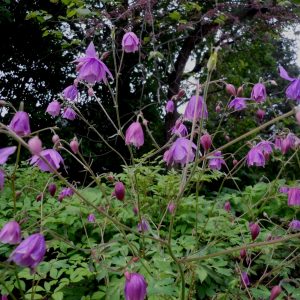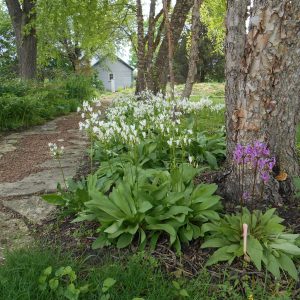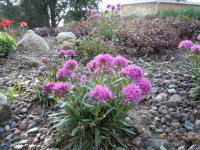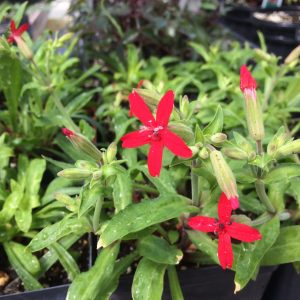Archives
Showing 161–168 of 199 results
-
Selinum wallichianum syn. S. tenuifolium Milk parsley Z 6-10
All summer filigree of lacy, fern-like foliage then in late summer -fall white domes, 8” across, each dome made of multiple balls atop purple-red stems.
ARCHIVED
Note: This is a plant not currently for sale. This is an archive page preserved for informational use.
“Queen of umbellifers,” EA Bowles. All summer filigree of lacy, fern-like foliage then in late summer -fall white domes, 8” across, each dome made of multiple balls atop purple-red stems.
Size: 3-5’ x 3’
Care: sun to part shade in moist well-drained to well-drained soil
Native: Himalayas
Wildlife Value: butterfly magnet
Awards: recipient of the Royal Horticultural Society Award of Garden MeritOriginally named Cortia lindeyi in 1830 Prodromus Systematis Naturalis Regni Vegetabilis 4: 186. Named for Dutch physician and botanist Nathanial Wallich (1786-1854). Rural Himalayan residents use this for spice, incense and fodder.
-
Semiaquilegia ecalcarata Spurless columbine, Z 5-9
Dainty dusty plum-pink columbine-like blossoms, without the tail, dangle above divided lobed foliage in May-June.
ARCHIVED
Note: This is a plant not currently for sale. This is an archive page preserved for informational use.
Dainty dusty plum-pink columbine-like blossoms, without the tail, dangle above divided lobed foliage in May-June.
Size: 6-10” x 8”
Care: sun to part shade in well-drained soil
Native: open woods and slopes in central China & Tibet
Awards: Royal Horticultural Society Award of Garden MeritCollected before 1891. Named “Wu ju lou dou cai” in Chinese.
-
Sesleria nitida Nest Moor grass Z 5-8
Spike-like panicles of white turn purple atop mounds of gray-blue blades
ARCHIVED
Note: This is a plant not currently for sale. This is an archive page preserved for informational use.
In early spring, about the time Robins appear, spike-like panicles of white turn purple atop mounds of gray-blue blades
Size: 24”x16”
Care: sun to part shade in most any soil
Native: central and southern ItalyCollected before 1861.
-
Shade Garden
Shade Garden.
ARCHIVED
Note: This collection is not currently for sale. This is an archive page preserved for informational use.
Shade Garden Size : Height x width* Bloom color
3 Asarum canadense – Wild ginger 6” x 6” spreading brown
3 Astilbe chinensis 24” x 24” pink
1 Brunnera macrophyllum – Siberian bugloss 18″ x 24″ blue
1 Chelone glabra – Turtlehead 2-4’ x 12” white
1 Disporum flavens – Fairy bells 25-30” x 16-20” yellow
3 Dodecatheon meadia – Shooting star 12-24” x 6-12” white
1 Hosta ‘Blue Cadet’ 35-40” x 36” lavender
1 Primula veris – Cowslip 8”x 8” yellow
3 Stylophorum diphyllum – Celantine poppy 12-18” x 12” yellow
1 Tricyrtis hirta – Toadlily 2-3’ x 2’ white & purpleAll plants are perennials.
If planted together in one garden these make a 30 square foot garden. **Most of these plants get wider over time by spreading roots or by self-seeding . -
Silene alpestris Alpine catchfly Z. 5-8
It flowers in May (through August) the flowers being of a polished whiteness
ARCHIVED
Note: This is a plant not currently for sale. This is an archive page preserved for informational use.
“It flowers in May (through August) the flowers being of a polished whiteness, with the petals notched, and abundantly produced over the shining green masses of leaves.” Robinson 1903
Size: 4-6” x 8-12"
Care: full sun in well-drained soil
Native: European AlpsCollected in Austria by 1773
-
Silene caroliniana Wild Pink, Carolina campion, Sticky catchfly Z 4-8
In spring loose clusters of rose-pink flowers with five spreading wedge-shaped petals
ARCHIVED
Note: This is a plant not currently for sale. This is an archive page preserved for informational use.
In spring loose clusters of rose-pink flowers with five spreading wedge-shaped petals
Size: 12” x12”
Care: sun to part shade in well-drained soil
Native: eastern and central North America
Wildlife Value: attracts Bees and ButterfliesNamed and described by Thomas Walter, 1788.
-
Silene suecica syn. Lychnis alpina Arctic campion Z 4-8
Rosy racemes May- June emerge from a mound of grass-like leaves
ARCHIVED
Note: This is a plant not currently for sale. This is an archive page preserved for informational use.
Rosy racemes May- June emerge from a mound of grass-like leaves. Short-lived but reseeds.
Size: 5” x 6”
Care: Sun to part shade in moist well-drained soil
Native: Northern Asia & EuropeLychnis named by Theophrastus in the 3rd century B.C. for “lamp” (lychnos) due to using the leaves of Lychnis coronaria for lamp wicks, but some say due to the flame-colored flowers. Collected by moss expert George Don at Meikle Kilrannoch, Scotland in 1795. May 6, 1876 “The Garden” described its flowers as “forming bright rosy patches…”
-
Silene virginica Fire pink Z 4-8 Short-lived perennial, 2-3 years
Real red, hence the name Fire (not pink in color), flowers of five notched petals flaring out from a tube, blooms late spring and early summer. Named “pink” because it is botanically in the family known as Pinks, Dianthus.
ARCHIVED
Note: This is a plant not currently for sale. This is an archive page preserved for informational use.
Real red, hence the name Fire (not pink in color), flowers of five notched petals flaring out from a tube, blooms late spring and early summer. Named “pink” because it is botanically in the family known as Pinks, Dianthus.
Size: 12-18” x 9-18”
Care: part shade in moist well-drained to well-drained soil.
Native: nearly entire eastern half of No. America. Endangered species in WI.
Wildlife Value: attracts hummingbirds.1st collected by John Banister (1654-1692) Anglican minister who searched and found many plants in the Virginia colony, losing his life when he was accidentally shot along the Roanoke River while collecting plants.







